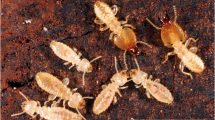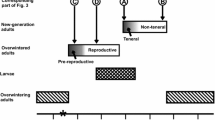Abstract
We report the identification of a defensive secretion from the green lacewing, Chrysoperla carnea. By using combined gas chromatography–electroantennographic detection (GC-EAD), we found one major compound in the solvent extract of this secretion that elicited a significant EAD response from the antenna. Based upon its characteristic fragments from gas chromatography–mass spectrometry (GC-MS) analysis, the compound was identified as a tridecene. Dimethyldisulfide derivatization suggested that a double bond was located between positions 4 and 5 in the carbon chain. Thus, the compound was tentatively identified as a 4-tridecene. Coinjection of the extract with a mixture of the Z or E form of the synthetic 4-tridecene revealed that the unknown was (Z)-4-tridecene. EAG dose–responses showed a direct correlation to dose. Single sensillum recordings from sensilla trichodea situated on the antennae suggested the presence of receptor neurons specifically responding to this compound. An arrestment behavior was observed when tested in the Y-tube olfactometer. Preliminary field trapping results indicate that the compound is an antagonist to attraction. The avoidance behavior of predatory ants, observed when tested with the synthetic compound of this secretion further suggested a defensive function.
Similar content being viewed by others
REFERENCES
Attygalle, A. B., and Morgan, E. D. 1984. Chemicals from the glands of ants. Chem. Soc. Rev. 13:245-278.
Blum, M. S. 1981. Chemical Defenses of Arthropods. Academic Press, New York, 562 pp.
Blum, M. S., and Wallace, J. B. 1973. Skatole and tridecene: Identification and possible role in achrysopid secretion. Insect Biochem. 3:353-357.
Boo, K. S., Chung, I. B., Han, K. S., Pickett, J. A., and Wadhams, L. J. 1998. Response of the lacewing Chrysopa cognata to pheromones of its aphid prey. J. Chem. Ecol. 24:631-643.
Buser, H.-R., Arn, H., Guerin, P., and Rauscher, S. 1983. Determination of double bond position in monounsaturated acetates by mass spectrometry of dimethyl disulfide adducts. Anal. Chem 55:818-822.
Clancy, D. W. 1946. The insect parasites of the Chrysopidae (Neuroptera). Univ. Calif. Publ. Entomol. 7:403-496.
Evans, H. E. 1978. A solitary wasp that preys upon lacewings (Hymenoptera, Sphecidae; Neuroptera, Chrysopidae). Psyche Camb. 85:81-84.
Henry, C. S. 1979. Accoustical communication during courtship and mating in the green lacewing Chrysopa carnea (Neuroptera, Chrysopidae). Ann. Entomol. Soc. Am. 72:68-79.
Hubel, D. H. 1957. Tungsten microelectrode for recording from single units. Science 125:549-550.
Jones, S. L., Lingren, P. D., and Bee, M. J. 1977. Diel periodicity of feeding, mating, and oviposition of adult Chrysopa carnea. Ann. Entomol. Soc. Am. 70:43-47.
Lanne, B. S., BergstrÖm, G., and LÖfqvist, J. 1988. Dufour gland alkenes from the four ant species: F. polyctena, F. lugubris, F. truncorum, and F. uralensis. Comp. Biochem. Physiol 91:729-734.
Mclachlan, R. 1874. The British species of Chrysopa examined with regard to their powers of emitting bad odors. Entomol. Mon. Mag. 2:138-139.
New, T. R. 1975. The biology of Chrysopidae and Hemerobiidae (Neuroptera), with reference to their usage as biological agents: a review. Trans. R. Entomol. Soc. London. 127:115-140.
Ridgway, R. L., and Kinzer, R. E. 1974. Chrysopids as predators of crop pests. Entomophaga 7:45-51.
Ruberson, J. R., Tauber, C. A., and Tauber, M. J. 1995. Developmental effects of host and temperature on Telenomus spp. (Hymenoptera: Scelionidae) parasitizing chrysopid eggs. Biol. Cont 5:245-250.
Tauber, M. J., Tauber, C. A., Danne, K. M., and Hagen, K. S. 2000. Commercialization of predators: Recent lessons from green lacewings (Neuroptera: Chrysopidae: Chrysoperla). Am. Entomol. 46:26-38.
Zhu, J. W., CossÉ, A. A., Obrycki, J. J., Boo, K. S., and Baker, T. C. 1999. Olfactory reactions of the twelve-spotted lady beetle, Coleomegilla maculata and the green lacewing, Chrysoperla carnea to semiochemicals released from their prey and host plant: Electroantennogram and behavioral responses. J. Chem. Ecol. 25:1163-1177.
Author information
Authors and Affiliations
Rights and permissions
About this article
Cite this article
Zhu, J., Unelius, R.C., Park, KC. et al. Identification of (Z)-4-tridecene from Defensive Secretion of Green Lacewing, Chrysoperla carnea. J Chem Ecol 26, 2421–2434 (2000). https://doi.org/10.1023/A:1005587113469
Issue Date:
DOI: https://doi.org/10.1023/A:1005587113469




